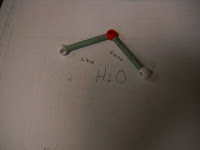Safety precautions:•closed toe shoes
•protective aprons and eye wear
•keep solvents under fume hood (hexane)
Task at hand:
Determine the reaction of certain solvents (H2O, C6H14, CH3OH, C3H7OH) with different colored inks while staying safe and using the proper materials.
♦PART I
Hypothesis:
Water would be the best solvent because in previous experiences while using black ink, water was spilled and the ink turned colorful and spread throughout the page.
Materials:
-overhead black ink pen
-4 cut strips of filter paper (approx. 1cm x 8cm)
-well plate
-(opt.) graduated cylinder
-4 solutions
-hexane (C
6H
14)-methanol (CH
3OH)
-isopropyl (C
3H
7OH)
-water (H
2O)
○Procedure:
1) fill four separate wells on the 24 well plate approximately half full of each of the four solvents.
2) make a right angle bend at one end of each filter paper strip approx. 1.5 cm from end.
3) mark a pencil line near the crease of each fold
4) Make multiple ink blots on each crease of filter paper
5) Place the small end of each filter paper into filled wells.
-place long end up strips on graduated cylinder to help progress
6) Allow solvents to wick up the papers for about 30 minutes.
7) Record observations.
○Observations:
The strip dipped in water progressed the most and is the most colorful. The second most colorful was the strip dipped in methanol. The colors fan out toward edges the farther the travel up the strips. The hexane is making the black dot thicker but doesn't actually separate colors. Isopropyl slowly spread the black up the paper but the colors consist of only black and dark blue. On January 28, 2010, the stop time for the solvents and reactions was 11:04 am.
○Results:

♦PART II
Hypothesis:
With water, green will be the one made of the most colors because it's the only one being used that isn't a base color.
materials:
-4 different colored markers
-green, orange, blue, red
-4 wells filled with H
2O
-4 cut strips of filter paper (approx. 1cm x 8cm)
-(opt.) graduated cylinder
○Procedure:
1.) Repeat steps 1-7 in PART I with 4 different colored inks
○Results:


Green, with the widest variety of color, was the only mixture in the group of colors. Of the pure (base) colors, red ranged the most in color from light pink to dark red, and blue and orange had very little variety at all.
♦CONCLUSION:
Water was proven the best solvent for the chromatography lab as its polarity separated the colors the most efficiently
While doing the experiment, we learned how different solvents react to the pigments in the ink
1) In PART I, the solvents ranked from best to worst for the separation as: H2O, CH3OH, C3H7OH, and C6H14
2) Some solvents worked better than other did on the ink because some had stronger polarities and attracted other atoms more efficiently
3) The ink in the black pen is a mixture, as shown by the multiple colors on the strip
4) C6H14 wasn't an appropriate solvent from PART I to use for PART II. Because of its weak polarity, it was the least capable of the solvents for the experiment
5) Blue, orange and red were classified as pure substances, whereas the green was a mixture
6) Chomatography is a technique for separating components of a mixture by placing the mixture in a mobile phase that is passed over a stationary phase.













